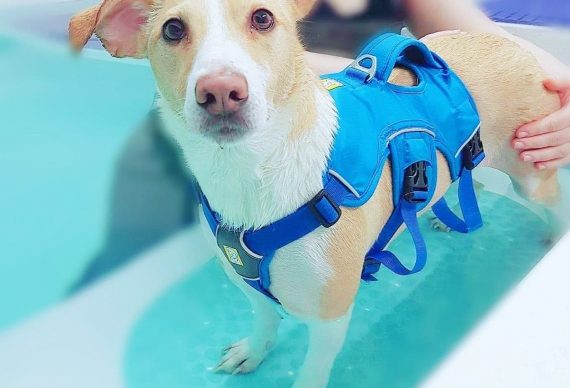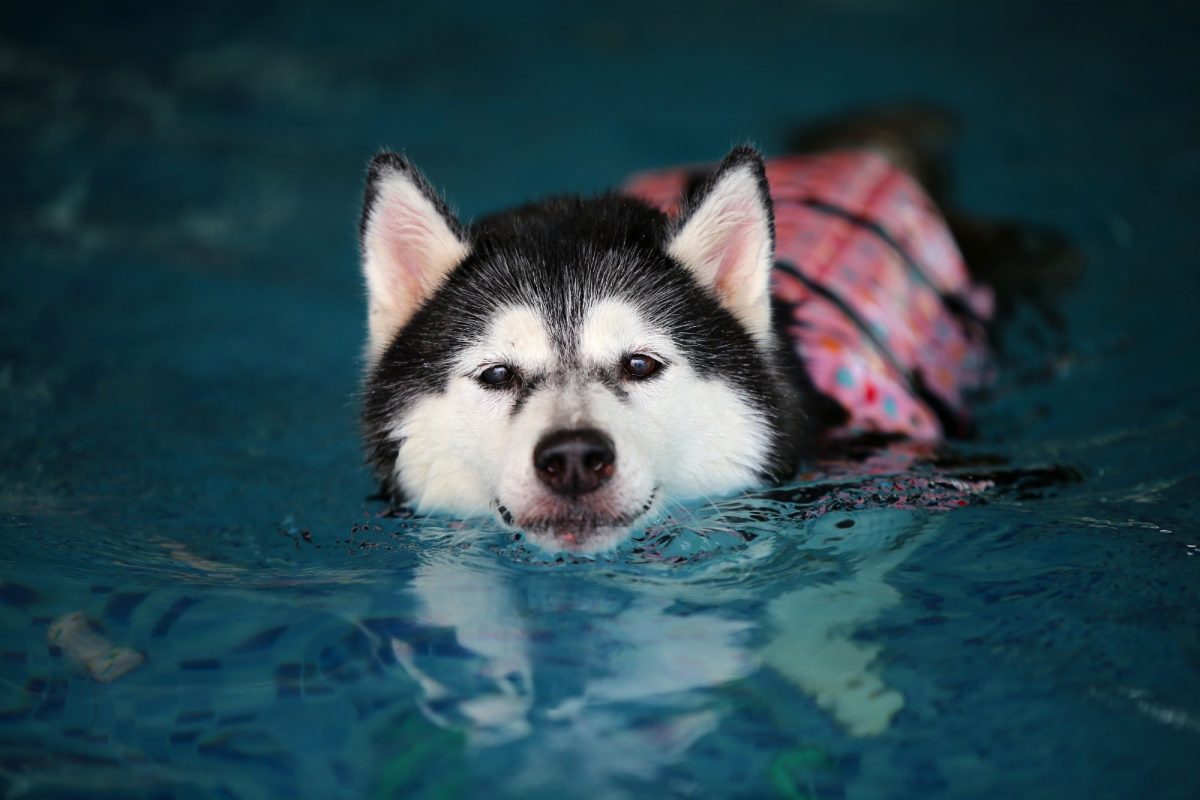What is Canine Hydrotherapy?
Hydrotherapy is a form of controlled and reduced weight bearing exercise in warm water. Exercise in water is an important way to improve muscle tone, strength, cardiovascular fitness and is great for weight control! The properties of water encourage a greater range of movement without the associated pressure or pain on joints meaning that the recovery from injury or surgery is much quicker too. Muscle wastage begins within 3 days of any inactivity. If you have a dog who is reluctant to weight bear on land – they can often begin their rehabilitation process much sooner preventing further weakness and rebuilding their muscle mass and tone.

Booking a Session
All we need is a completed Veterinary Referral form prior to your visit. Booking an appointment is easy and you can choose one of the following options:
Download the veterinary consent form and ask your vet to complete the necessary details. If you contact us directly we can talk you through the process and often contact your vet on your behalf.
*Sometimes we are unable to answer the phone as we may be treating a dog, please do leave us an answer phone message and we will return your call as soon as we can.
What to expect from your first hydrotherapy session
Your first session includes a full initial assessment and will be approximately 1hr. We will run through your referral and discuss your dog’s history with you. We will then perform a thorough health check of your dog which includes:
- assessing range of movement
- assessing gait
- weighing your pet
- taking measurements of muscle mass
- assessing proprioception
- a full health check.
During this process, your hydrotherapist will be using this information combined with your dogs history and referral paperwork to formulate a treatment plan for your dog. We will discuss this with you and then introduce your dog to either the pool or the treadmill.
What to expect from an introduction to the pool or treadmill
Preparation for both sessions is the same and would begin with some sensory shower work which helps to stimulate muscle groups before entry into the pool or treadmill. Next we will fit an appropriate harness which could be either a floatation jacket or standard harness used for safely swimming dogs.
The Pool – The patient will be gently led up the ramp to the pool. Some dogs are extremely enthusiastic about this whilst for others it’s not uncommon for them to ‘put the brakes on’ at this stage and refuse to go any further, this is part of the reason initial assessments are so long – we want the experience to be as enjoyable as possible for your dog so we don’t mind spending the extra time building their confidence and trust getting into the pool.
Once in the pool, we will use one of our resting platforms and gently massage your dog before encouraging them off the platform and into the water. A variety of toys can be used to motivate your dog, and you are also welcome to encourage your dog too.
The Treadmill – We will gently lead the patient to the open door of the treadmill where we will walk them through from one side to another to get them used to walking up and down the ramps and through a strange piece of equipment. On the next entry into the UWTM we will close the doors and begin to fill the chamber with water with the desired level selected based on the condition and aims of the sessions. The treadmill will then start and initially an appropriate speed will be selected to encourage a steady walking gait.
After the session
Your dog will have a sensory shower to help to cool down the muscles and remove any chlorine from the coat. We also then towel dry your dog before using the dryer. Not all dogs appreciate a blow-dry so please let us know if your dog would rather avoid this part of the procedure!
Please note
Each dog responds differently and it is important to us to ensure the experience is as positive as possible for your pet whilst we build their trust and assess their response to the session therefore the initial time in either the pool or treadmill can be quite short.
What is hydrotherapy used for?
- Arthritis management
- Cruciate injuries/repairs
- Hip and elbow dysplasia
- Neurological conditions
- Muscle wastage
- Obesity/weight management
- Patella luxation/repairs
- Soft tissue injuries (ligament damage)
- Spinal surgery/Intervertebral disk disease
How does hydrotherapy help my dog? What are the benefits?
Having water heated to therapeutic levels of between 29 – 31 degrees increases circulation, provides immediate pain relief and reduces swelling.
Other positive effects include:
- Increased circulation of blood to the muscles / increased tissue healing
- Relief of pain, swelling, stiffness and muscle spasms
- Increased range of movement and function
- Improved muscle strength and tone
- Improved cardiovascular fitness
- Improved mental wellbeing
- Improved gait patterns

Frequently Asked Questions
We are often asked lots of questions by owners about services we offer, hopefully we can answer most of them here:
We can’t treat your dog without it, even if it is for a fun or fitness swim. The consent form gives us information on your dogs specific condition and requirements ensuring we have all the information needed for an effective session.
Don’t worry this is more common than you think and we can also safely lift your dog into the pool (although we might ask for your help)! There are no steps to negotiate on your way into the centre which should make things easier too.
Dogs are not encouraged to launch themselves into the pool for a number of reasons. They can take on board too much water and potentially suffer from water intoxication/secondary drowning. If your dog is being treated for a specific condition for example elbow dysplasia, the impact of landing repeatedly in the water and breaking the surface tension can actually hinder the recovery process. We run our sessions in a controlled way – but we still do have fun!
We all know that many dogs love swimming in the sea, lakes and lovely stinky ditches and ponds! However it isn’t the best environment as there are many hidden dangers including strong currents, which are often cold and can catch out even the strongest of swimmers.
It isn’t possible to monitor exercise in these environments either, and cold water is actually counter-productive for a dogs with joint problems or osteoarthritis, causing painful and stiff muscles. It’s really important for these dogs to swim within a therapeutic temperature range to provide optimum healing, recovery and pain relief!
